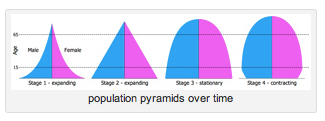The first American baby boomers turn 65 this year, marking the start of a geezer boom that will see as many as 10,000 erstwhile hippies qualifying for senior discounts every day for the next 18 years (globally, the stat tops 125,000 per day). As all things baby boom, it is a marketer’s dream, complete with an MIT lab devoted to designing products and services to help seniors “‘do things’ throughout the lifespan,” and anti-aging hucksters lining up for a piece of a multi-billion dollar pie.
The bigger story, though, is about demographic distribution, visualized in “population pyramids.”
When a population is young, the graph looks like a pyramid, with children at the bottom far outnumbering their elders. Epidemics, wars and natural disasters chip chip away at a pyramid’s profile, but nothing chips more dramatically than contraception. It is no coincidence that the US baby boom ended a few years after “The Pill” was approved by the FDA in the early 1960s. Contraception has also played a key role battling skyrocketing birth rates in developing countries, with collateral benefits for women’s rights and economic improvement.










